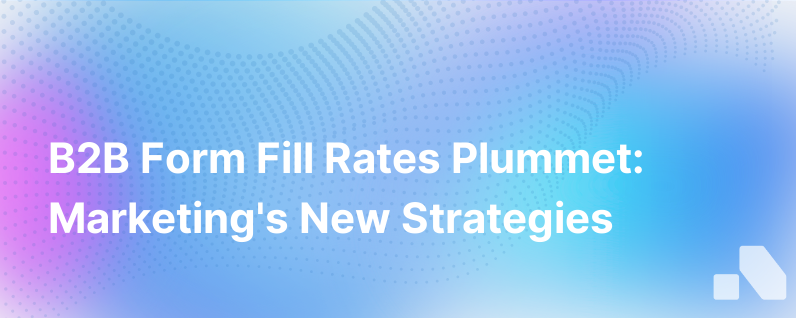
In the realm of B2B marketing, the efficacy of campaigns is often gauged by performance metrics; among them, form fill rates stand out as a crucial indicator of engagement and interest levels. Alarmingly, today's B2B marketers are grappling with diminishing form fill rates. As the effectiveness of a direct line to prospective customers wanes, marketing organizations are compelled to rethink strategies to curb this decline.
The Challenge with Low Form Fill Rates
The conundrum of dwindling form filling stems from several factors. The modern era has ushered in a digital fatigue, with individuals continually bombarded by content. Additionally, privacy concerns heighten the reluctance to share information. Furthermore, the proliferation of content across multiple channels has spoiled B2B decision-makers with choices, rendering their patience thin for lengthy or intrusive forms.
Strategic Overhauls to Combat Declining Rates
Progressive B2B marketing organizations employ innovative strategies to address these low form fill rates. The recalibration involves both minor tweaks and broad strategic realignments, all underpinned with a staunch focus on enhancing the user experience and providing value.
Humanizing the User Experience
Foremost in this strategic shift is the embracement of conversational marketing. Instead of static forms, interactive chatbots and live chat functionalities entice users into a dialogue. B2B marketers craft these experiences to be akin to an engaging conversation with a knowledgeable consultant rather than a faceless entity. By doing so, organizations can seamlessly collect data in a less obstructive way.
The Advent of Content Marketing Strategies
In view of decision-makers being inundated with materials, content marketing strategies now prioritize quality over quantity. Developing high-caliber, targeted content adds substantial value for prospects and cultivates a reputation for thought leadership. Quality content can effectively lure prospective clients into initiating the data-sharing process themselves, organically leading to increased form submissions.
Gating Less, Guiding More
Savvy marketing organizations have learned to gate less content, instead offering more upfront value with no strings attached. The traditional gating model is being counterbalanced with a trust-based approach, where substantial content is accessible without the immediate need for a trade-off. The theory posits that by demonstrating value first, customers will subsequently be more willing to exchange information voluntarily.
Multi-Touch Attribution Models
Modern data analytics tools enable marketers to employ multi-touch attribution models that help to quantify the full user journey across various touchpoints. Refined insights from these models guide organizations to allocate resources to activities that directly influence form fill rates. Multi-touch attribution fosters an environment where form fills are one of many valuable interactions, rather than a single point of failure.
Personalization at Scale
Advancements in AI help B2B marketers tailor the user experience, including form interactions, to individual preferences and behaviors. Personalized forms that adapt the number and type of fields based on user data demonstrate higher engagement rates. AI tools allow for just-in-time personalization, delivering unique experiences at scale to increase form fill rates.
Rethinking the Form Itself
The form's design and user interface no longer take a backseat. Crafted to enhance user interaction, forms are concise, intuitive, and visually pleasing. Progressive disclosure techniques allow for longer forms to feel less daunting by revealing additional fields gradually. The goal is to minimize friction and make the form-filling process feel effortless.
Leveraging Social Proof and Security Badges
Understanding the import of privacy and trust, organizations are fortifying forms with assurances. Testimonials, customer logos, and security badges increase confidence in the form's legitimacy and the organization's reputation, which can translate to higher form fill rates.
Analytics and Continuous Optimizations
A/B testing of form length, language, and design has become a cornerstone of performance optimization. Marketing organizations diligently assess which variations yield the best results and incessantly refine their forms accordingly. This scientific approach to form optimization is indispensable for enhancing submission rates.
Progressive Profiling Techniques
Rather than demanding a wealth of information upfront, which often deters completion, organizations are deploying progressive profiling. On subsequent visits, returning users encounter pre-filled information and are asked to provide additional details gradually. This approach respects the user’s time and builds upon existing data, thereby fostering a more comprehensive customer profile over time.
Mobile-First Form Experience
Given the ubiquity of mobile devices in professional contexts, B2B marketing organizations ensure forms are mobile-friendly. A seamless mobile form-filling experience captures a demographic that would otherwise be lost to desktop-only optimization.
Conclusion
The decline in form fill rates presents both a challenge and an opportunity for innovation within B2B marketing. By leveraging technology, fostering genuine relationships, and adopting a customer-centric approach, marketers can reverse the downward trend. While the landscape of lead generation evolves, so too must the strategies organizations use to engage potential buyers.
In an age where every interaction can be meaningful, data capture becomes nuanced, and the focus shifts to creating value every step of the way. It's a shift from form-first to customer-first; and it's reshaping the future of B2B marketing. As these organizations adapt and refine their strategies, they'll likely discover that their investments to revitalize form fill rates could result in more profound relationships and a deeper understanding of their customers.
Indeed, the efforts made to understand and tackle the low form fill rate challenge are a testament to the evolving intelligence and resilience of B2B marketing practices.